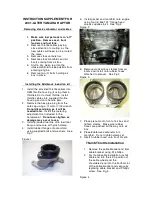
06 Starting and driving
116
General
06
Economical driving
Driving economically means driving smoothly
while thinking ahead and adjusting your driv-
ing style and speed to the prevailing condi-
tions.
• Get the engine warmed up as soon as
possible.
• Do not let the engine idle, but drive at light
loads as soon as it is possible.
• A cold engine consumes more fuel than a
warm one.
• Avoid braking too hard.
• Do not drive with unnecessary loads in the
car.
• Do not use winter tyres when the roads
are dry.
• Remove load carriers when they are not
being used.
• Avoid driving with open windows.
Slippery driving conditions
Practise driving on slippery surfaces under
controlled conditions to learn how the car
reacts.
Engine and cooling system
Under special conditions, for example when
driving in hilly terrain, extreme heat or with
heavy loads, there is a risk that the engine
and cooling system will overheat.
Avoid overheating the cooling system
• Maintain a low speed when driving with a
trailer up long, steep ascents.
• Do not turn the engine off immediately you
stop after a hard drive.
• Remove any auxiliary lamps from in front
of the grille if driving in extreme high
temperatures.
Avoid overheating the engine
Do not exceed engine speeds of 4500 rpm
(diesel engine: 3500 rpm) if driving with a
trailer or caravan in hilly terrain. The oil tem-
perature could then become too high.
Open boot lid
Avoid driving with the boot lid open. If it is
necessary to drive with the boot lid open for
a short distance:
– Close all windows.
– Set the air distribution to the windscreen
and floor and run the fan at high speed.
Driving in water
The car can be driven through water at a
maximum depth of 25 cm at a maximum
speed of 10 km/h. Extra caution should be
exercised when passing through flowing
water.
When driving in water, maintain a low speed
and do not stop the car. When the water has
been passed, depress the brake pedal lightly
and check that full brake function is attained.
Water and mud for example can make the
brake linings wet resulting in delayed brake
function.
Clean the electric contacts of the electric
engine block heater and trailer coupling after
driving in water and mud.
WARNING
Do not drive with the boot lid open. Toxic
exhaust fumes can be drawn into the car
through the cargo area.
IMPORTANT
Engine damage can occur if water enters
the air filter.
In greater depths, water can enter the trans-
mission. This reduces the lubricating ability
of the oils and shortens the service life of
these systems.
IMPORTANT
Do not let the car stand with water over the
sills for any long period of time. This could
cause electrical malfunctions.
In the event of stalling in water, do not try to
restart. Tow the car out of the water.
Summary of Contents for 2008 C70
Page 1: ...WEB EDITION VOLVO C70 owner s manual...
Page 12: ...01 SAFETY...
Page 34: ...02 INSTRUMENTS AND CONTROLS...
Page 64: ...02 Instruments and controls 63 02...
Page 66: ...03 CLIMATE CONTROL...
Page 76: ...04 INTERIOR...
Page 87: ...04 Interior 86 Storage spaces in the passenger compartment 04 6 1 2 3 4 5 9 10 7 8 G019514...
Page 96: ...05 LOCKS AND ALARM...
Page 116: ...06 STARTING AND DRIVING...
Page 150: ...06 Starting and driving 149 Detachable towbar 06 Push on the protective cover G017318...
Page 154: ...07 WHEELS AND TYRES...
Page 169: ...168 Cleaning 170 Touching up paintwork 173 Rustproofing 174...
Page 170: ...08 CAR CARE...
Page 176: ...08 Car care 175 08...
Page 178: ...09 MAINTENANCE AND SERVICE...
Page 204: ...09 Maintenance and service 203 09...
Page 206: ...10 INFOTAINMENT SYSTEM...
Page 230: ...10 Infotainment system 229 10...
Page 232: ...11 SPECIFICATIONS...
















































